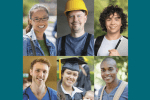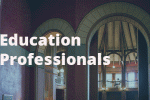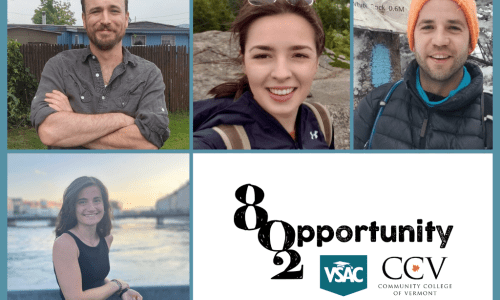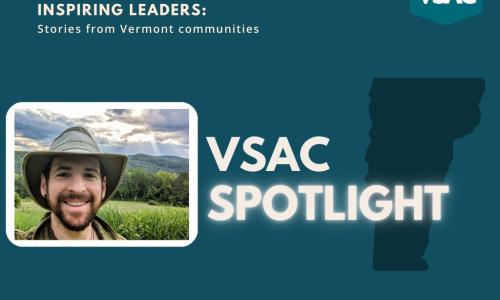Planning for college or training this year? Apply for the Vermont Grant.
Don’t miss out on financial aid for college or job training

Autumn is a great time to plan for college and job training, so when spring arrives, you’ll be ready for next steps. If you’re looking forward to starting or continuing your education, but don’t know where to begin—you’re not alone!
Most good-paying, high-demand jobs in Vermont require some form of education or training after high school. There’s a lot to consider, and you might feel overwhelmed. Although education can seem complicated and expensive, it’s an investment—and there are many ways to finance your future. Various forms of “financial aid” (free money and more) may be available to reduce your overall cost of college or job training programs.
As helpful as money can be, it’s also important to take care of yourself throughout the process. Starting to plan now will help you ease stress, and you’ll be able to make the most of what may feel like a weighty decision. Starting early allows you to:
- Gather all the information you need
- Choose from a wide range of programs
- Take time to make decisions
- Set yourself up for success!
And no matter where you are as you navigate academic and job goals, VSAC is here to help.
Helping teens, families, and adult learners plan and pay for college or job training
VSAC supports people of all ages, with all kinds of goals. We’re here to help you achieve your education and training objectives. You may be:
- A high school student
- A parent of a junior or senior in high school
- An adult learner seeking to advance your goals by reskilling
- An adult learner interested in learning more about a new career with short-term training
If you’re looking for solutions to finance college or job training, VSAC can answer your questions and provide guidance. You may be building toward goals that include:
- Trade school
- Job certification
- 2-year college
- 4-year college or university
- Graduate school
Whatever your path may be, VSAC knows the ins and outs of finding financing for your unique situation. Tap into VSAC’s expertise and resources for help navigating life and learning after high school. Start by taking a look our extensive financial aid resources.
There’s money for college or job training, and VSAC can help you get it
Students receive financial aid from a variety of different sources. While the primary responsibility for paying for education lies with the family—parents and students—there’s money to help bridge the gap.
Costs of college or training after high school can include:
- Tuition and fees: classes and programs
- Housing and meals: living arrangements and meal plan
- Books and supplies
- Other expenses: transportation, personal items, computer, etc.
Families pay their net price by combining:
- Savings: even small amounts can reduce the need for borrowing
- Current income: such as tuition payment plans, which allow you to spread payments out over the year
- Work-study: campus jobs offered by a college to provide students with income each semester
- Future income: education loans or other borrowing
Financial aid is meant as a supplement to assist students who wouldn’t be able to continue their education without help.
Don’t miss out: learn about funding to help pay for what’s next
The net price of attending school is based on the total cost of attendance, minus grants, scholarships, and other aid that you don’t have to pay back. The net price will vary from school to school, and there are many tools available to help students knock back the cost of education. Check out VSAC's free Financial Aid brochure for more information about these options:
- FAFSA: This free application unlocks all forms of federal, state and school financial aid including grants, scholarships, and more. This year the FAFSA for the 2025-2026 academic year opens by December 1. We can help you with your application!
- Grants: Grants are free money that you don’t need to pay back. Find out what you qualify for by completing your Vermont grant application. The VSAC Vermont Grant Application for 2025-2026 is open now.
- Scholarships: This is more free money, offered by many different groups and organizations. VSAC manages more than 150 scholarships—apply for every opportunity you may be eligible for! The VSAC Unified Scholarship Application for 2025-2026 is open now.
- Military funding: There are many education funding programs for members of the armed forces, veterans, and their families that can offset college and training costs. Some familiar programs may be ROTC, the National Guard Tuition Benefit Program, the Minuteman Scholarship, and the Montgomery GI Bill.
- Job training: VSAC offers programs that can reduce or even eliminate the costs of education for jobs in high-demand fields, including trades. Explore the range of available programs.
- Loans: Loans are borrowed money that must be paid back with interest. We’ll help you learn to reduce your borrowing costs and pay less over the life of a loan. Learn more about financial aid, what to look for when comparing loans, how interest works, and ways to minimize education debt with VSAC’s free Education Loans Guide.
About the FAFSA: We’ll help you apply
The FAFSA, or Free Application for Federal Student Aid, is key to your financial aid process. The FAFSA is the starting point for:
- Federal grants such as the Pell grant
- State grants like the Vermont Grant, administered by VSAC
- Scholarships, including as a part of VSAC’s Unified Scholarship Application
- Work-study, institutional aid, and other programs
- Federal Direct loans
You may have heard about FAFSA difficulties from last winter and spring; perhaps hearing about others’ experiences has left you feeling reluctant to take that first step to file the FAFSA this year. The U.S. Department of Education Office of Federal Student Aid (FSA) plans to open the 2025-2026 academic year FAFSA by December 1. (Typically, the FAFSA opens October 1.) This year FSA says that it will take October and November to put the FAFSA through rigorous testing, fix bugs, and improve project oversight with the goal of offering a better FAFSA experience for students and families.
VSAC supported students throughout the last academic year and through the summer. From one-on-one counseling to a host of financial aid resources, experienced VSAC counselors have solutions to help get you through the process.
Consider taking a moment now to get ready to file the FAFSA when FSA opens the form later this year. Begin to gather the following:
- StudentAid.gov account (formerly FSA ID). Students and contributors (often, parents) must each have their own account.
- Your Social Security number. (If you or your parents do not have a Social Security number, contact VSAC—we can help.)
- Your 2023 tax records.
- Record of assets, including child support, current balances of cash, savings, and checking accounts, and net worth of investments, businesses, or a farm.
- Your contributor’s information, including their name, date of birth, email, and Social Security number (if they have one).
- The list of schools you’re applying to (if you’re a high school senior) or your current school’s name. (The list of schools that you’re applying to can also be updated in future months.)
VSAC will guide you through the process
Don't miss out on free money for education. Get help in applying for financial aid, including grants and scholarships for Vermonters, funding for college and job training, and more.
Have questions? Contact us at 800-642-3177, 8 a.m. to 4:30 p.m., Monday through Friday, or by email at info@vsac.org.






